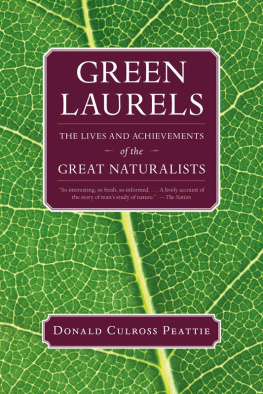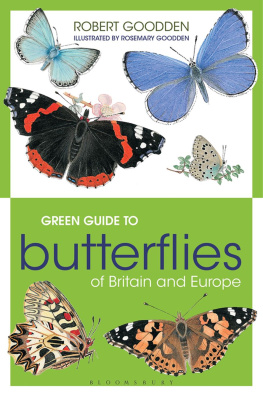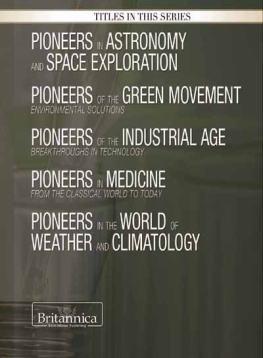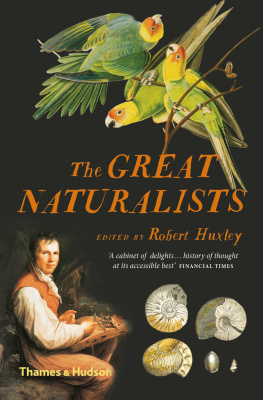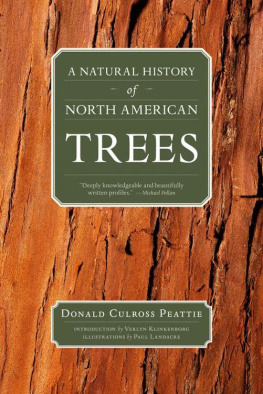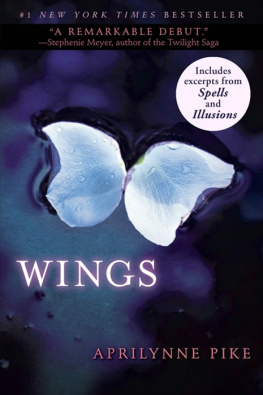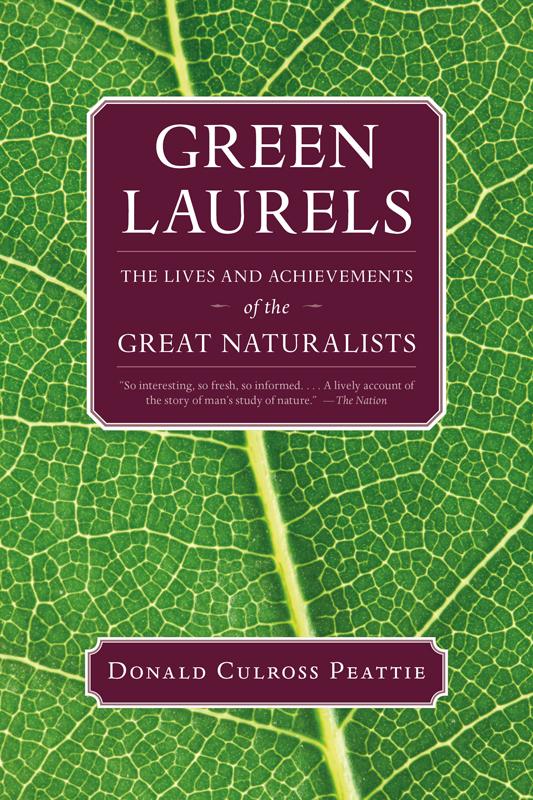
i
DONALD CULROSS PEATTIE LIBRARY
PUBLISHED BY TRINITY UNIVERSITY PRESS
An Almanac for Moderns
A Book of Hours
Cargoes and Harvests
Diversions of the Field
Flowering Earth
A Gathering of Birds:
An Anthology of the Best Ornithological Prose
Green Laurels:
The Lives and Achievements of the Great Naturalists
A Natural History of North American Trees
The Road of a Naturalist
ii
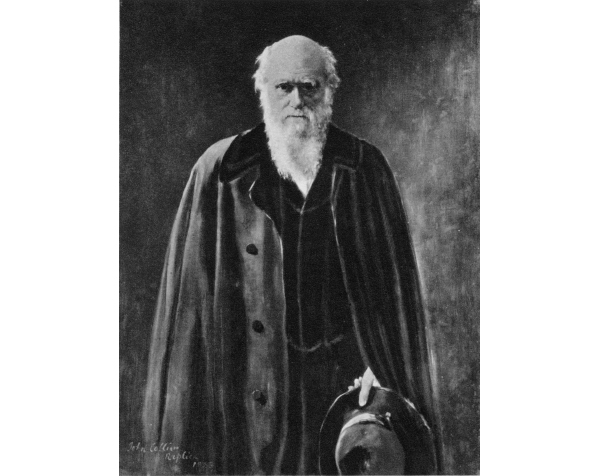
C harles D arwin
Portrait by John Collier.
(Courtesy of the National Portrait Gallery, London)
iv
Published by Trinity University Press
San Antonio, Texas 78212
Copyright 2013 by the Estate of Donald Culross Peattie
Copyright 1936 by Donald Culross Peattie
isbn 978-1-59534-164-8 (paper)
isbn 978-1-59534-165-5 (ebook)
Cover design by BookMatters, Berkeley
Cover illustration: vtorous/istockphoto.com
All rights reserved. No part of this book may be reproduced in any form or by any electronic or mechanical means, including information storage and retrieval systems, without permission in writing from the publisher.
Trinity university Press strives to produce its books using methods and materials in an environmentally sensitive manner. We favor working with manufacturers that practice sustainable management of all natural resources, produce paper using recycled stock, and manage forests with the best possible practices for people, biodiversity, and sustainability. The press is a member of the Green Press Initiative, a nonprofit program dedicated to supporting publishers in their efforts to reduce their impacts on endangered forests, climate change, and forest-dependent communities.
The paper used in this publication meets the minimum requirements of the american national standard for information sciencesPermanence of Paper for Printed Library Materials, ansi 39.48-1992.
CIP data on file at the library of Congress.
17 16 15 14 13 | 5 4 3 2 1
v
To the friend who in the green dusk led me from Trinity Pass to Paradise
vii
ACKNOWLEDGMENTS
For permission to quote from the volumes listed below the author and publishers of this book make grateful acknowledgment to
Alfred A. Knopf, New York, T he N atural H istory of A nts, by Reaumur, translated by William Morton Wheeler (1926).
Henry Holt and Co., New York, T he G rowth of B iology, by William Locy (1925).
Appleton-Century Co., New York, T he N ew H armony M ovement, by George B. Lockwood (1905).
The Clarendon Press, Oxford, H istory of B otany , by Julius von Sachs (1890).
University Press, Cambridge, D iary of the V oyage of the B eagle, by Charles Darwin, edited by Nora Barlow (1933).
H. F. & G. Witherby, Ltd., London, L innaeus, by Dr. B. D. Jackson (1923).
Historical Department of Iowa, Des Moines, R afinesque, A S ketch of H is L ife, by T. J. Fitzpatrick (1911).
The Filson Club, Louisville, L ife and W ritings of R afinesque, by Richard Ellsworth Call (1895).
The Indiana Historical Commission, Indianapolis, I ndiana as S een by E arly T ravelers, edited by Lindley Harlow (1916).
ix
CONTENTS
The dusty window of the Middle Ages. The Schoolmen. What Aristotle really was, and his medieval ossification. Platonic idealism. The herbalists gradually slough off notions of sorcery. Early botany and zology. The Renaissance: Bauhin, Gesner, Belon, Aldrovandi, Rondelet, etc.
The wonderworld of the microscope. Invention of the first microscopes. The spirit of investigation in the seventeenth century. Rise of learned societies. Malpighi begins the anatomical investigation of insects; Swammerdam discovers their metamorphoses; Leeuwenhoek, the consummate amateur, looks at the whole world through a lens. The precocity of early microscopy followed inevitably by sterility.
An age of encyclopedias. Buffon, courtier and pet of the Pompadour, becomes zologist laureate to the most brilliant court on earth. Sets out to write the natural history of the world. His temperament, his style, his faults, his views, his jealousy of Raumur, his troubles with the Sorbonne. Reaumur the metallurgist, meteorologist, chemist, physicist, and, above all, entomologist. How his posthumous writings were suppressed, and unearthed only in our own time. Last days of Buffon.
x
Linnaeus: his birthplace, parentage, childhood. The influence of northern Nature on his mind; his scholastic training; his poverty and struggles. His friendship with Artedi; they plan the great new Systema Naturae. Rudbeck and Celsius befriend Linnaeus. On the Marriage of Plants. He sets forth upon the great spring journey to Lapland.
Results of the Lapland expedition. Its fame spreads through Europe. Linnaeus, exploring Dalecarlia, falls in love with Sara Moraea. Unable to marry her, he sets off for a tour of Europe, visiting Germany, Holland, England, and France. The brilliant offers made him. Publication of his revolutionary systems. Reunion with Artedi; death of Artedi. Linnaeus in England encounters strong opposition but triumphs completely. The Linnaean system. He returns to wed his Sara Lisa.
The great field trips. The famous students at Upsala. Student life and play. Last days and death of Linnaeus. The classic era of collecting; the world ransacked, especially for the rare. Museums over-run with specimens. Pedantry and sterility fall on Linnaean science; the collecting mania of amateur fanciers enters to complete the disgrace. The reputation of Linnaeus in temporary eclipse. His immortal greatness as systematist and personality.
Lamarcks background. Lamarck the soldier. He walks in Monaco and ponders lifes infinite variation. Paris and Rousseau. xi Our ignorance of Lamarcks private life. He becomes a botanist, then a zologist. His tree of life and great theory of evolution through adaptation to environment.
Appearance of Georges Cuvier. Greatness and weakness as anatomist. Lamarcks blindness, poverty, death. Cuviers opposition to Lamarckism. Lamarcks theories sink to low repute. Their revival in our day.
An Eden awaiting the coming of the naturalists. Summary of some very early natural history surveys. John Bartram, Quaker, and botanist to the King, our first native-born naturalist. His son William, half-mad genius, extends his researches. Importance of the wilderness for our early naturalists. The gallant Frenchman, Michaux, and his adventures among the seeds and flowers of Appalachia. His son Franois the first great forester of America.
The birds of America. Alexander Wilson in Scotland, weaver, peddler, poet. His brush with Burns. Has to destroy his lampoons publicly ; leaves for America. Combines schoolmastering and natural history. The young Audubon not forty miles away making the first bird-banding experiments. His origins and lucky love affair. Wilsons hardships, melancholy temperament, thrice unlucky affairs of the heart. Determines to describe the birds of America. The scope of his achievement. The famous meeting of Americas two first ornithologists; temperamental differences. The great Audubon-Wilson controversy. xii Wilsons unhappy end. Estimate of Audubons contribution to science.
The pioneers attitude toward American Nature and to Science. The naturalists go West; the Boatload of Knowledge: Robert Owen, Lesueur, Say. New Harmonys Golden Age and twilight decay. The amazing career of Rafinesque. His genius, his troubles at Transylvania College, his eccentricity, the madness and sorrows of his old age.
Next page
